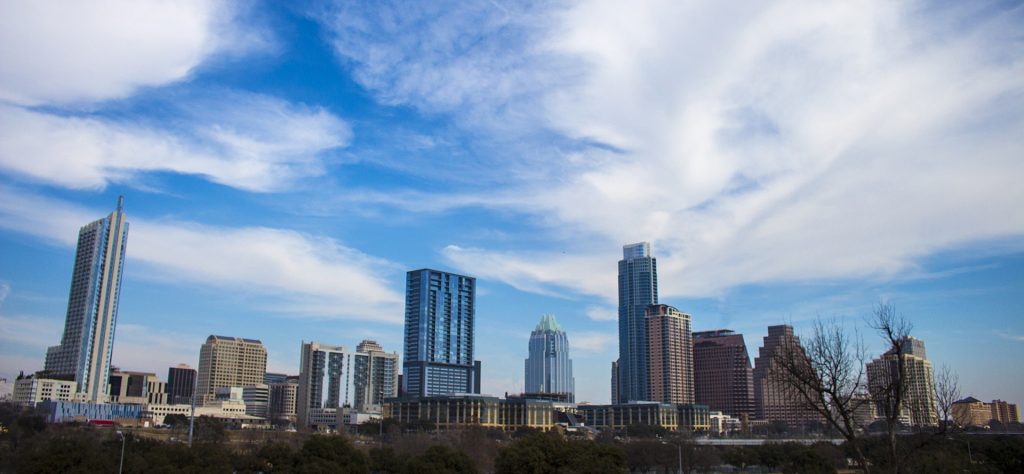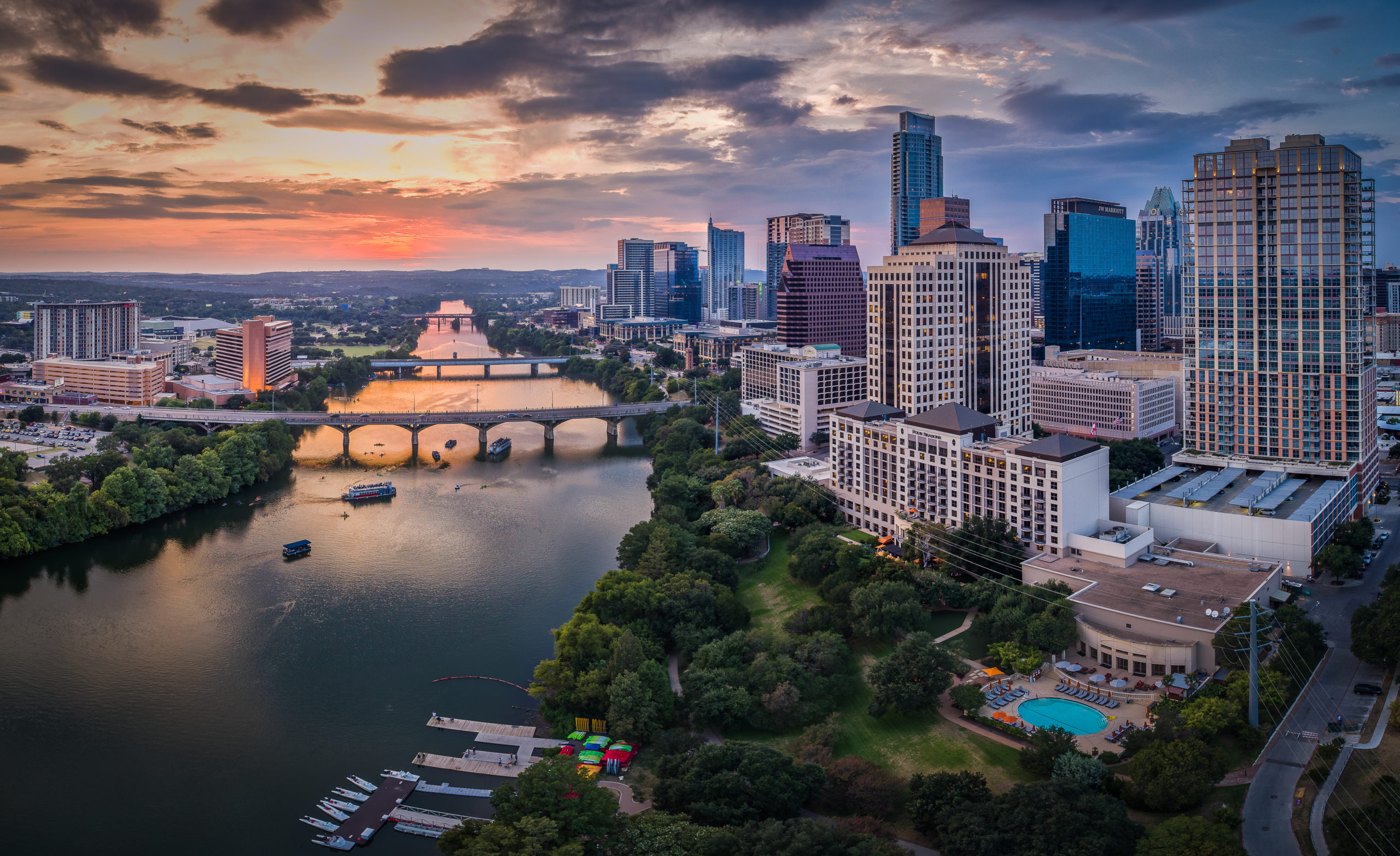When you thought of Texas, you didn’t use to think of Austin. If you thought of any city — and you probably didn’t because the most evocative image of Texas is probably an endless, untamed prairie — you thought of Dallas, with its “Big Rich” lords and ladies ruling over thousand-acre ranches. Or maybe you thought of industrious Houston, where West Texas Intermediate crude oil is refined into gasoline, and a control room full of earnest young men in short-sleeved white shirts and horn-rimmed glasses send Apollo spacecraft to the moon. Or maybe you thought of San Antonio, that in the heart of Texas cowtown where Davy Crockett, Jim Bowie and a handful of other bravos held off the entire Mexican army and sacrificed themselves at the Alamo for the cause of Texian independence.
Maybe in fifth grade, you had to remember — just long enough to pass a test — that Austin is the state’s capital. You might have caught a live music show called Austin City Limits, where you might hear Willie Nelson, and Run the Jewels play on the same night. Or more likely not unless you’re a passionate music festival goer. This long-running music festival also aired on television for longer than American Bandstand, but it aired on PBS.
Austin is still the capital. It still has an eclectic music scene. And it still has some of that university-town charm reminiscent of Boulder, Colorado, or Madison, Wisconsin thanks to the University of Texas and its passionate college football fan base. But Austin has outgrown all those convenient labels, and it keeps growing. No wonder the multifamily real estate market is so hot there, and why young out-of-towners are flocking there to find their little corner of this burgeoning city.

From Silicon to Citizen
U.S. News & World Report named Austin the No. 1 place in the U.S. to live two years running. So the secret is out.
Young people often come to town for education — the University of Texas at Austin is considered one of the top IT schools in the country and is certainly one of the greatest educational bargains to be had — but stay because Austin is also where the jobs are.
Many Fortune 500 companies — tech firms, in particular, have regional offices in Austin: Amazon, Cisco, eBay, Google, IBM, Intel, Oracle and PayPal leading the list. General Motors is also a major employer. Two homegrown companies — Whole Foods and Dell — still have worldwide headquarters in the area. Now that Whole Foods is owned by Amazon, maybe we should be including it as just another tech company that found a home in Silicon Hills, as the cluster of high-tech companies in the city is commonly known.
“[T]echnology companies have announced expansions in the metro,” according to Yardi Matrix. “Among them is Apple’s $1 billion, 133-acre development that’s slated to house 15,000 employees once fully operational, as well as WeWork’s rumored $1 billion mixed-use development that’s likely to encompass 3 million square feet of office, residential, hotel, shops and restaurant space.”
The New Neighbors
Millennials are a big part of the story when it comes to Austin’s growing population, but they are not the only drivers. Surprisingly, there’s less than a two-year age difference between the average resident of Texas and the average resident of the state’s capital, according to City-Data.com, which pegs an Austinite as 32.7 years old on average. The much bigger difference is in household income: $66,696 in town compared to a $56,565 statewide median. Austinites are more likely than most other Texans to be employed in management or sales and are twice as likely to be in information technology. They’re also more than twice as likely to have finished four years of college or to have attained a graduate degree. That would go a long way toward explaining why their home prices are also double those of the average Lone Star State tract.
There are other quirks of Austin’s demography. First, its residents are particularly non-religious. Unaffiliated residents far outnumber all denominations combined; this is one of the few cities in the south where there are more Catholics than Evangelicals, and where mainline Protestants have been able to maintain their relatively small numbers. And, for whatever it’s worth, the plurality of Austin residents have never been married. Also, compared to other large American cities, Austin displays a fairly low degree of ethnic diversity. There are relatively few black households; in fact, African-Americans barely exceed Asian-Americans in Austin — not what one might expect from an area that was dotted with thriving, predominantly black “freedom towns” during Reconstruction. Today, though, almost half of all Austin households are white, while roughly one-third are Hispanic.
But there are other kinds of diversity — musical tastes for one. It would be hyperbolic to say the live music scene in Austin is beyond compare, but you’d have to drive 12 hours to find such a talent-heavy and genre-spanning performance space elsewhere. Just follow the signs to Nashville. It should also be noted that Austin has probably the liveliest LGBTQ scene in the mid-South.
Austin does indeed have something for everyone — at least for everyone who defines themselves by their biography rather than their history. During the late 19th century, Austin promoted itself as “the City of the Violet Crown,” at once a commentary on the glowing colors of the hills right after sunset, and a classical reference to the Greek epic poet Pindar’s description of ancient Athens. But these days, the town’s unofficial but universally recognized slogan is “Keep Austin Weird.”
Finding Space
Let’s start with Austin’s biggest draw: its bars. This is no joke: the 78701 ZIP code — comprised of Downtown, North Side, the Medical District, Rainey Street Historic District, the Seaholm District and the eastern portion of the Market District — tops City-Data’s list of ZIP codes with the most alcohol-serving establishments. The post office that serves Austin’s urban core delivers mail to more watering holes than the one that serves New York’s East Village (10003) or New Orleans’s French Quarter (70130) or the next three down the list — which are all in Chicago. This is even more amazing when you consider that Austin’s Downtown — aside from a couple of 700-foot condo towers — is much more commercially zoned than those other neighborhoods, so the resident-to-bar ratio is truly astonishing.
Austin is home to roughly 1 million people — more like 2.2 million if you include the entire Austin-Round Rock metropolitan area. That’s big enough to make it the 11th-largest city in the U.S. Unlike most big cities, though, the current wave of development has more to do with filling in the gaps in the landscape than with changing the center-city skyline.
In 2017, Forbes gave the South River City neighborhood a second-place ranking for “Best Cities and Neighborhoods for Millennials,” which raises the question: Where exactly are they moving in and around Austin?
Neighborhoods.com lists what it considers to be Austin’s five top Millennial magnets:
- East Austin only looks low-rent. It’s one of the pricier neighborhoods, given its proximity to the offices, government buildings, sports arenas and aforementioned bars of the Downtown area. Small, independent businesses — a touchstone of life in Austin — abound in this hipster redoubt.
- Hyde Park, three miles up I-35 from Downtown, maintains a slower pace but shares the city’s penchant for quirky, homegrown businesses.
- South Congress, or SoCo, has developed its own nightlife a half hour’s drive south of downtown. It’s also a bit pricier than some neighborhoods closer to the urban core.
- South Lamar, a less developed, more open neighborhood on the way from Downtown to SoCo, might be the best place to find a bargain apartment.
- Old West is, as the name implies, west of the urban core, just past the UT main campus. Because of some very strict zoning laws, multifamily development is very limited and thus high-occupancy unit rents are sky-high by local standards.
That’s Not All
These neighborhoods, though, are more on the wishlist for new Austin residents than on their realistic home-hunting tours. “The three most active submarkets had a combined confirmed sales volume of $422 million in 2018,” Yardi Matrix reports. “East Central Austin ($182 million), San Marcos/Kyle ($133 million) and Sunset Valley ($107 million).”
Still, growth remains impressive, even if it might be slowing down at this point in the cycle. “Steady hiring in Austin since 2009 has resulted in the creation of more than 300,000 jobs, attracting thousands of new residents over the past several years,” Marcus & Millichap reports”. The positive net in-migration of an average 40,000 individuals during each of the past five years has placed additional strain on the housing market as single-family and multifamily developers have struggled to keep pace with rising demand… New home construction and multifamily deliveries are anticipated to dip during 2019, while strong demand factors remain in place. As a result, vacancy will stay below 6% this year, marking a decade below this threshold.”
Austin at a Glance
- Construction (projected, 2019): 7,500 units, down from a steady 9,000 per year from 2014 to 2018
- Occupancy rate (January 2019): 94.5%, up 60 basis points year-over-year.
- Annual rent (year-end 2018): $1,353, up 4.5% year-over-year; another 2.0% increase projected over the course of 2019
Sources: Marcus & Millichap, Yardi Matrix
Sharestates Recently Funded Projects in Austin
Sharestates has been forging new relationships with borrowers in the Austin metro area and recently funded a few noteworthy projects there. Click the button below to view some recently funded Sharestates projects in the Austin area!


